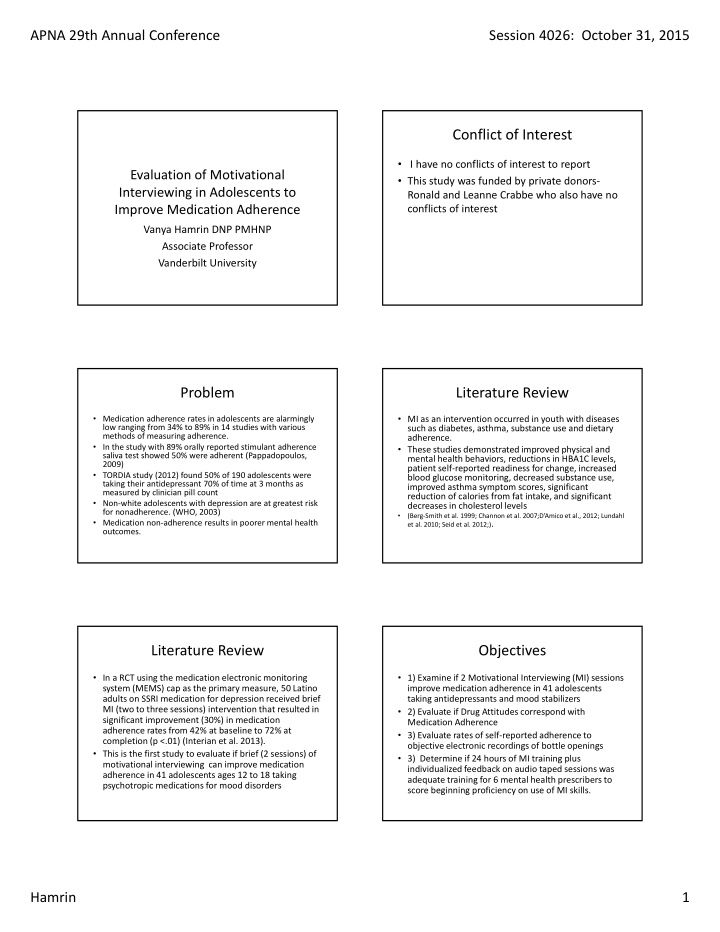



APNA 29th Annual Conference Session 4026: October 31, 2015 Conflict of Interest • I have no conflicts of interest to report Evaluation of Motivational • This study was funded by private donors ‐ Interviewing in Adolescents to Ronald and Leanne Crabbe who also have no Improve Medication Adherence conflicts of interest Vanya Hamrin DNP PMHNP Associate Professor Vanderbilt University Problem Literature Review • Medication adherence rates in adolescents are alarmingly • MI as an intervention occurred in youth with diseases low ranging from 34% to 89% in 14 studies with various such as diabetes, asthma, substance use and dietary methods of measuring adherence. adherence. • In the study with 89% orally reported stimulant adherence • These studies demonstrated improved physical and saliva test showed 50% were adherent (Pappadopoulos, mental health behaviors, reductions in HBA1C levels, 2009) patient self ‐ reported readiness for change, increased • TORDIA study (2012) found 50% of 190 adolescents were blood glucose monitoring, decreased substance use, taking their antidepressant 70% of time at 3 months as improved asthma symptom scores, significant measured by clinician pill count reduction of calories from fat intake, and significant • Non ‐ white adolescents with depression are at greatest risk decreases in cholesterol levels for nonadherence. (WHO, 2003) (Berg ‐ Smith et al. 1999; Channon et al. 2007;D’Amico et al., 2012; Lundahl • • Medication non ‐ adherence results in poorer mental health et al. 2010; Seid et al. 2012;) . outcomes. Literature Review Objectives • In a RCT using the medication electronic monitoring • 1) Examine if 2 Motivational Interviewing (MI) sessions system (MEMS) cap as the primary measure, 50 Latino improve medication adherence in 41 adolescents adults on SSRI medication for depression received brief taking antidepressants and mood stabilizers MI (two to three sessions) intervention that resulted in • 2) Evaluate if Drug Attitudes correspond with significant improvement (30%) in medication Medication Adherence adherence rates from 42% at baseline to 72% at • 3) Evaluate rates of self ‐ reported adherence to completion (p <.01) (Interian et al. 2013). objective electronic recordings of bottle openings • This is the first study to evaluate if brief (2 sessions) of • 3) Determine if 24 hours of MI training plus motivational interviewing can improve medication individualized feedback on audio taped sessions was adherence in 41 adolescents ages 12 to 18 taking adequate training for 6 mental health prescribers to psychotropic medications for mood disorders score beginning proficiency on use of MI skills. Hamrin 1
APNA 29th Annual Conference Session 4026: October 31, 2015 What is Motivational Interviewing Methods • Motivational Interviewing (MI) is a collaborative, goal ‐ • The quasi ‐ experimental study trained 6 oriented style of communication attention to the language prescribers (4 NP’s and 2 child psychiatrists) to of change. perform MI • Strengthen personal motivation and commitment to a specific goal by eliciting and exploring a person’s own • Measured adolescent medication adherence reasons for change within an atmosphere of acceptance and compassion ( Miller & Rollnick, 2012 ). to antidepressants/mood stabilizers using • The key elements of MI: Medication Electronic Monitoring System improve the clinician’s working alliance with a client • (MEMS) before and after 2 MI sessions teach clinicians to manage resistance, to express empathy • delivered by the prescriber in standardized 30 towards clients, and to help clients build motivation to change while addressing ambivalence to change (Miller & minute medication appointments. Rollnick, 2012). Design Interventionist Participants Inclusion Criteria : 12 prescribers were invited to participate from the outpatient child • • and adolescent clinic, four training fellows declined to participate in Eligibility included adolescents 12 to 18 years of age, of either gender and • any ethnicity, currently receiving SSRI/SNRI or mood stabilizing treatment the study and two child psychiatrists declined due to not being able at the university outpatient clinic for a minimum of one month. There was to participate in the 3 day MI training no maximum length of time on medication. 6 faculty (4 nurse practitioners & 2 child psychiatrists) voluntarily • The adolescents needed to be able to read, write, and speak English to • agreed to participate in the study & signed IRB consent. complete the rating scales. All prescribers were Caucasian and female. • Exclusion Criteria : • 3 nurse practitioners were master’s prepared • Adolescents with verbal communication deficits were not included in the • 1 nurse practitioner was doctorally prepared. study, as MI requires significant dialogue between the clinician and • adolescent. The two child psychiatrists were both doctorally prepared. • Intellectual impairment (IQ below 70) and self ‐ care impairment were • Of the prescribers, five had greater than 10 years of experience, • excluded as the intervention of MI involves planning and processing skills one had 3 years of experience, none of the prescribers had any as well as independence in activities of daily living. previous formal training in MI. Illiteracy and lack of self ‐ care skills and current psychosis. • Design Design • Evaluation of each participant’s practice of taking • During the first month (30 days), patient medication for 30 days by MEMS cap and the attitude adherence to medication was monitored of each adolescent toward medication occurred before electronically using the MEMS cap & patient and after 2 MI sessions were completed. oral report. • Only the SSRI/SNRI and mood stabilizer adherence was monitored by the MEMS cap system. Patients were on • Drug attitude score (DAI) obtained at baseline average of 2.5 psychiatric medications • At the start of the 2nd and 3rd months, each The study evaluated if MI (independent variable) plus • standardized medication treatment improved patient had 1 MI session within their monthly psychotropic medication adherence (dependent medication management in 30 minute variable) compared to medication adherence at appointment with a trained MI prescriber baseline. Hamrin 2
Recommend
More recommend